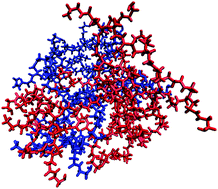Molecular dynamics simulations of polyaminoamide (PAMAM) dendrimer aggregates: molecular shape, hydrogen bonds and local dynamics
Abstract
By means of Molecular Dynamic simulations we study over a wide range of temperature (200–400 K) the static and dynamics of polyaminoamide bulk dendrimers of third (16 end-groups) and fourth (32 end-groups) generations. The simulations show a very weak effect of the temperature on all the static properties analyzed (gyration radius, distribution of monomers, degree of dendrimer interpenetration) and, surprisingly, almost no interpenetration between dendrimers of the third generation. Unexpectedly, the propensity of forming inter-dendrimer hydrogen bonds is similar in both models but the intra-dendrimer hydrogen bonds turn out to be stronger in the fourth generation dendrimers than in the third generation ones. The terminal amine-groups are characterized by higher mobility if compared with the internal monomers. Finally, the detailed analysis of the local relaxation of the CH bonds shows that in the fourth generation dendrimers there is a decrease in the local dynamics moving from the inner toward the outer shells. This hierarchical behavior is not found in dendrimers of third generation.


 Please wait while we load your content...
Please wait while we load your content...